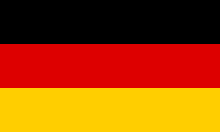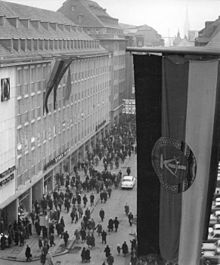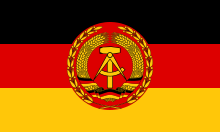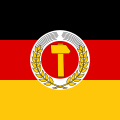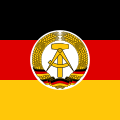Flag of the German Democratic Republic
| Flag of the German Democratic Republic | |
|---|---|
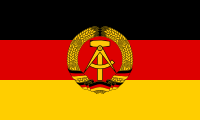 |
|
| Vexillological symbol : |
|
| Aspect ratio: | 3: 5 |
| Officially accepted: | October 1, 1959 |
The flag of the German Democratic Republic , like the flags of the Federal Republic of Germany and the Weimar Republic , showed the colors black, red and gold . From 1959, the GDR's national coat of arms with a hammer, compass and wreath of ears was in the middle of the red color .
history
On the centenary of the March days in Berlin in March 1948, the second People's Congress was convened in Berlin. As the German People's Council for the reorganization of the entire state, it was supposed to create a national flag for the state in addition to drafting a constitution for the German Democratic Republic. There were three flags to choose from, one red , one black-white-red and one black-red-gold. The proposal to introduce the red flag was quickly rejected. As a symbol of communism and the international labor movement, this flag was already rejected by the bourgeoisie for the November Revolution of 1918 (and after). As in the Federal Republic , the decision should be made in favor of the black, red and gold flag of the Weimar Republic. The Soviet Union was initially against this flag . As a symbol of the Weimar Republic, it reminds us of times of weakness, crises and unemployment. That left the black-white-red flag. It goes back to the National Committee for Free Germany . The committee founded on June 12 and 13, 1943 under Soviet leadership adopted the old Reich flag. The flag should be seen as a symbol of the struggle against the fascist Nazi regime under Adolf Hitler and the swastika flag.
At the Third People's Congress in 1949, the Lord Mayor of East Berlin, Friedrich Ebert , who was appointed by the Soviet occupation forces in 1948, again proposed the black, red and gold flag. His application was approved on May 30, 1949 and entered into force on October 7, 1949, the day the GDR was founded.
As a result, the German Democratic Republic and the Federal Republic of Germany carried identical national flags until, after ten years of existence, on October 1, 1959, the GDR added its national coat of arms, "hammer and compass, surrounded by a wreath of ears", to the flag in order to make a distinction to create the flag of the Federal Republic of Germany. The coat of arms was intended as a symbol of the alliance of workers , peasants and the intelligentsia .
The public presentation of this flag, officially known as the "Soviet Zone Flag" and sometimes also as the "Spalter flag", was seen as a violation of the constitution and a disruption of public order in the Federal Republic of Germany and West Berlin until the end of the 1960s basically prevented by police measures (→ declaration by the federal and state interior ministers , October 1959). When the GDR flag was raised abroad, there were also stereotypical West German protests. It was not until July 22, 1969 that the Federal Government ( Grand Coalition ) decreed "that the police should no longer intervene anywhere against the use of the flag and coat of arms of the GDR."
Since the GDR was not yet recognized under international law , teams with athletes from both parts of Germany started in sporting competitions, such as the Olympic Games , until 1968 . The Olympic Committee of the GDR refused to compete under the flag of the Federal Republic, and the Olympic Committee of the Federal Republic of Germany insisted until the last moment not to make any changes to the black-red-gold flag. In the end, an agreement was reached. The white Olympic rings were placed on the red stripes of the black, red and gold flag . In the course of the recognition of the GDR under international law by the United Nations and the recognition of the sovereignty of the GDR by the Federal Republic of Germany, two separate German teams took part from 1972 with their respective flags.
With the introduction of the new state flag in 1959, a new trade flag was also introduced. Before that, the GDR also used the black, red and gold flag without a coat of arms as a trade flag. With the new trade flag there is a smaller national coat of arms in the upper corner. In 1973 this trade flag was abolished and replaced by the state flag, which was thus the national and trade flag.
After the political change in the GDR in 1989, the working group “New Constitution of the GDR” of the Round Table drafted a new constitution and proposed a new state flag. It should continue to be striped in black, red and gold, but instead of the national coat of arms, it should show the motto swords to plowshares . The further political events with the existence of the GDR ending with German reunification prevented the constitution and thus the new flag from coming into force.
In addition to the GDR flag, the labor movement's red flag was often hoisted on public buildings, at official events and on public holidays . Only on the Brandenburg Gate were there always two red flags waving to the left and right of the state flag of the GDR in the middle until the days after the opening of the Wall .
War and service flags
The flags of the military associations of the GDR carried the national coat of arms with a wreath of two olive branches on a red background in the black, red and gold flag.
The flags of the People's Navy for combat ships and boats carried the coat of arms with an olive branch wreath on a red, for auxiliary ships and boats on a blue flag cloth with a narrow black, red and gold ribbon in the middle. As a jack , the state flag was used in a reduced form.
The ships and boats of the coastal border brigade on the Baltic Sea and the boats of the border troops of the GDR on the Elbe and Oder wore a green bar on the leech just like the official flag of the border troops .

 ? Service flag of the National People's Army
? Service flag of the National People's Army
 ? ? Service flag of the Deutsche Post (1955–1973)
? ? Service flag of the Deutsche Post (1955–1973)

Standards
Standard of the Chairman of the State Council 1960–1990
Standard of the President 1951–1953
See also
- Standard of the President of the German Democratic Republic
- State coat of arms of the German Democratic Republic
- Flag of Germany
- List of flags of all of Germany
- List of national flags
- SBZ from A to Z, keyword "flag"
Individual evidence
- ↑ Law on state emblem and flag 26 September 1949 by
- ↑ Law amending the law on the state coat of arms and the state flag of the German Democratic Republic. From October 1, 1959
- ↑ Die Spalterflagge , Deutschlandfunk 2009
- ^ Ordinance on the introduction of a trade flag for the German Democratic Republic. From October 1, 1959
- ^ Draft Constitution of the German Democratic Republic, working group "New Constitution of the GDR" of the Round Table, Berlin, April 1990
- ↑ Article 43, draft constitution of the German Democratic Republic, working group “New Constitution of the GDR” of the Round Table, Berlin, April 1990
literature
- Karl-Heinz Hesmer: Flags coat of arms data. The countries of the world from A – Z. Bertelsmann Lexikon-Verlag, Gütersloh · Berlin · Munich · Vienna 1975, ISBN 3-570-01591-2 .
- Jörg M. Karaschewski : Flags in the GDR: The vexillological symbolism of the German Democratic Republic , 2015, ISBN 978-3739200255 .
- Whitney Smith , German Adaptation Ottfried Neubecker : The signs of people and peoples. Our world in flags and banners. Reich Verlag, Lucerne 1975, ISBN 3-7243-0115-4 .
